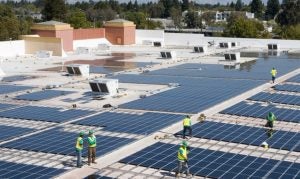 The Future Energy Jobs Act, which catapulted Illinois to the forefront of the clean energy movement, includes an ambitious directive for electric utilities to get 25 percent of their power from renewable resources by 2025. To achieve that, the Illinois Power Agency has been developing a Long-Term Renewable Resources Procurement Plan (the Plan) based on workshops and input from stakeholders, including Environmental Defense Fund (EDF).
The Future Energy Jobs Act, which catapulted Illinois to the forefront of the clean energy movement, includes an ambitious directive for electric utilities to get 25 percent of their power from renewable resources by 2025. To achieve that, the Illinois Power Agency has been developing a Long-Term Renewable Resources Procurement Plan (the Plan) based on workshops and input from stakeholders, including Environmental Defense Fund (EDF).
The Agency filed the Plan in December 2017 for the Illinois Commerce Commission’s approval. Following several more rounds of comments, it is now up to the Commission to make its final modifications to the Plan before approving it on April 3.
By jumpstarting Illinois’ renewables development, the Plan contains huge wins for the environment and people. But there are a few questions yet to be resolved. Here’s what you should know.
Major victories
There is something for all Illinoisans in the Plan – and then some. A few of the many reasons to celebrate include the following:
- Incentives for those who install solar projects, with relatively larger incentives for residential customers, who face higher costs in building solar systems
- Millions of dollars dedicated to building solar in disadvantaged and environmental justice communities (historically marginalized and underserved groups)
- A new community solar program, again with greater incentives for projects with residential and small commercial subscribers
- Safeguards against many pitfalls that have plagued other states, including strict consumer protections and strong locational requirements for projects
In sum, the Plan will mean increasingly more homes, businesses, and facilities in Illinois will be powered by clean, low-carbon wind and solar power.
The Illinois Power Agency worked diligently to educate stakeholders and consider parties’ views both before and after filing the Plan, but a few key issues remain on the table.
[Tweet “Illinois is about to release its plan to kick-start new renewables. Here’s what you need to know.”]
Short-term goals or long-term investment?
The Plan’s success will depend on its ability to kick-start a new solar industry in Illinois, provide equitable access to solar, and create long-term energy sustainability for the state. The Plan lays out an impressive framework to do just that, but we’d like to highlight one important change that EDF and our allies advocate.
The Future Energy Jobs Act emphasizes building new wind and solar projects within Illinois, and includes annual targets that ramp up to the ultimate 25 percent by 2025 goal. The strict budget afforded the Illinois Power Agency to pay for this renewable generation means the Agency should prioritize spending on new in-state projects, as opposed to purchasing short-term Renewable Energy Credits (RECs).
Purchased via “spot procurement,” the RECs at issue are tradable credits for units of energy from existing wind or solar generation. Unlike new solar or wind installations, which will produce renewable energy in Illinois for years to come, RECs from spot procurements represent a single year of renewable energy generated in Illinois (or an adjacent state that meets certain requirements).
Though they may help Illinois meet annual targets, short-term RECs do nothing for Illinois’ ambitious long-term goals.
Though they may help Illinois meet annual targets, these short-term RECs do nothing for Illinois’ ambitious long-term goals. Even worse, paying for them may jeopardize the state’s ability to fund long-term projects. The Commission will decide what is more important: meeting short-term targets, or ensuring enough money is set aside to support building in-state renewable projects.
Protecting smaller solar customers
EDF is also raising the alarm about one eleventh-hour suggestion that could roll back some of the Plan’s incentives for households and small commercial customers to subscribe to community solar projects.
It is generally more expensive to build a project that provides power for a lot of smaller subscribers than for just a handful of large subscribers, like industrial or big commercial customers. Therefore, developers often would rather build community solar projects for these large customers, rather than for people’s homes and small businesses.
The Plan gives small customers a fair shot at building community solar systems by providing additional incentives that recognize the particular challenges these customers face. But some solar developers are arguing to change these important aspects of the Plan, to open the door for developers to make more money while serving fewer people. We strongly oppose this last-minute suggestion.
Illinois’ renewable energy footprint is set to skyrocket, and it is now up to the Illinois Commerce Commission to decide how best to make that happen. Hopefully the Commission will recognize the importance of long-term renewables development over spot-procurement RECs, and protect the incentives for building community solar projects that serve smaller customers. Regardless, we are confident the Plan will put Illinois on a path to help people cut both electricity bills and carbon pollution.









